




2/77


Introduction
After world war one and world war two, 7 Field Company was disbanded and on each occasion, the company was soon again, reformed. After world war one, the company was reduced to a cadre, reformed in 1920 and posted out to Koln, as part of the first BAOR. In 1947 the Company was disbanded and reformed again in 1949 as 7 Field Squadron and was posted to Hameln, West Germany, as part of 21 Field Engineer Regt. In 1950 the Squadron transferred to 26 Field Engineer Regt, remaining in Hameln until 1957 when the Squadron moved to Osnabruck.
The Squadron served in Osnabruck as part of BAOR from November 1957 until January 1968. Most of my time with the Squadron was in Osnabruck. In January 1968 the Squadron moved to Deverell Barracks in Ripon but was still part of 6 Infantry Brigade. The Squadron moved back to Germany in 1971 as part of 32 Engineer Regiment. You can read some of Osnabruck's history on the '7 Sqn Osnabruck' page. From 1885 till the end of WW1, 7 Field Company was known as the 'Black Horse', it is believed that it was because at one time, the Company mainly had black horses, however, those who have looked into this cannot be affirmative as the answer seems to have been lost in the fog of time.
The Squadron became known as ‘Shiny 7’ between WW1 and WW2. It is said that 7 Field Company RE won an all units ‘Turnout’ competition in BAOR, between 1920 and 1929.
The Barracks
In Osnabruck, the Squadron was based in Roberts Barracks, better known to the local population as, Winklehausen Kaserne. It was named after Col Von Winklehausen, a WW1 Colonel. Before WW2 it was the home of Infantry Regiment 37, whom in 1939, served in France and in 1941 served in Russia, where they suffered severe casualties. The barracks were completed and opened in October 1935.
2 Division Engineers
From 1961 until April 1969 the squadron was part of 2 Div Engineers, which was made up of 7 Field Squadron, 16 Field Squadron and 43 Field Park Squadron, whom shared the same half of Roberts Barracks. The other half was occupied by 25 Corps Engineer Regiment.
After world war one and world war two, 7 Field Company was disbanded and on each occasion, the company was soon again, reformed. After world war one, the company was reduced to a cadre, reformed in 1920 and posted out to Koln, as part of the first BAOR. In 1947 the Company was disbanded and reformed again in 1949 as 7 Field Squadron and was posted to Hameln, West Germany, as part of 21 Field Engineer Regt. In 1950 the Squadron transferred to 26 Field Engineer Regt, remaining in Hameln until 1957 when the Squadron moved to Osnabruck.
The Squadron served in Osnabruck as part of BAOR from November 1957 until January 1968. Most of my time with the Squadron was in Osnabruck. In January 1968 the Squadron moved to Deverell Barracks in Ripon but was still part of 6 Infantry Brigade. The Squadron moved back to Germany in 1971 as part of 32 Engineer Regiment. You can read some of Osnabruck's history on the '7 Sqn Osnabruck' page. From 1885 till the end of WW1, 7 Field Company was known as the 'Black Horse', it is believed that it was because at one time, the Company mainly had black horses, however, those who have looked into this cannot be affirmative as the answer seems to have been lost in the fog of time.
The Squadron became known as ‘Shiny 7’ between WW1 and WW2. It is said that 7 Field Company RE won an all units ‘Turnout’ competition in BAOR, between 1920 and 1929.
The Barracks
In Osnabruck, the Squadron was based in Roberts Barracks, better known to the local population as, Winklehausen Kaserne. It was named after Col Von Winklehausen, a WW1 Colonel. Before WW2 it was the home of Infantry Regiment 37, whom in 1939, served in France and in 1941 served in Russia, where they suffered severe casualties. The barracks were completed and opened in October 1935.
2 Division Engineers
From 1961 until April 1969 the squadron was part of 2 Div Engineers, which was made up of 7 Field Squadron, 16 Field Squadron and 43 Field Park Squadron, whom shared the same half of Roberts Barracks. The other half was occupied by 25 Corps Engineer Regiment.


Mascot of
7 Field Company RE
7 Field Squadron RE
7 HQ & SP Squadron RE
7 Field Company RE
7 Field Squadron RE
7 HQ & SP Squadron RE
Osnabruck Coat of Arms

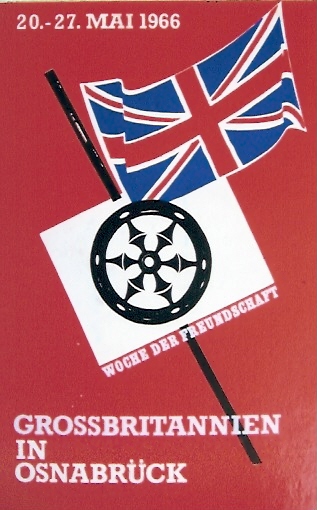



Photo with kind permission of Derek Stevenson 16 Fd Sqn Website
Looking through the main gate, the nearest block on LHS was part of 25 CER, 2nd left, Church Army. Opposite was the cookhouse and on the RHS the guardroom, which was contained in HQ block. In the 1960s, the road through the main gate on, An Der Nette Heide as seen above was more or less the centre of the camp, with 25 Corps Engrs occupying the left side of the road and 2 Div Engrs occupying the right side of the road.
Taxi cards from my scrap book. I used these taxi services many times, and you probably did too!!
Picture taken from the old block at Times Square
when the Sqn was independant. 1963/64
when the Sqn was independant. 1963/64

Brummie Crawford at Entrance to old block at Times Square
There was a British Week in 1966 to promote trade and friendship between the two countries. Roberts Barracks hosted some of the events




BAOR Shield
Typical Block Corridor

Beginning of City limits
This was the Regimental Cook House.
At the far end is the Guard Room and Main Gate
At the far end is the Guard Room and Main Gate
Leave Pass used for a trip to Amsterdam




Links:
Ex Bar Frost Bardufoss Norway September 1965


1 Troop Demolition Training Germany 1960s

1 Troop's Stalwart 08 ER 63
1967
1967




Pre Ex 'Bar Frost' training running up
the quarry slag heap Osnabruck 1965
the quarry slag heap Osnabruck 1965


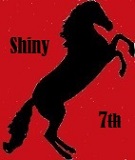
The Lendrim Trophy
The Lendrim Trophy presented to 7 HQ & SP SQN RE by the Shiny Seven Association for inter department competions, as yet to be decided.
The trophy was donated by Chris Ellis
The trophy was donated by Chris Ellis



Amazon Bridge
The bridge that had to be built - at all costs
The bridge that had to be built - at all costs
Amazon Bridge built under heavy enemy fire by the Royal Engineers of 4 BR DIV on the 12/13 May 1944. 225 Field Company - 7 Field Company - 59 Field Company.
Supported by: 18 Field Park Company RE - Detachment of 2 NF - Reserve - 578 Field Company RE
8 Fd Sqn RE in support of tank routes and mine clearance.
Supported by: 18 Field Park Company RE - Detachment of 2 NF - Reserve - 578 Field Company RE
8 Fd Sqn RE in support of tank routes and mine clearance.
Hier sitzen die,
die hier immer sitzen
die hier immer sitzen



More photos of Roberts Barracks:

"C" Squadron 17/21st Lancers
crossed Amazon Bridge 0500 hrs 13 May 1944
crossed Amazon Bridge 0500 hrs 13 May 1944


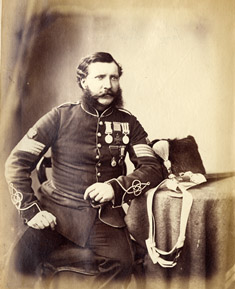
Cpl William James Lendrim, V.C. rose to be
Sergeant-Major William James Lendrim, V.C.
Sergeant-Major William James Lendrim, V.C.
Site Updates
7 Field Company RE, World War One Centenary Commemorations 1914-2014 to 1918-2018

Tellermine

End of City Limits
The 30,000th Last Post Ceremony at Menin Gate with the band of the Royal Engineers in attendance : https://www.youtube.com/watch?v=yV6Oo3Y_pf8
Home page updated - July 2021
New page - 1939 updated November 2020
The 1939-40 page, now 1940. updated December 2020
1941-42 page updated Jan 2021.
1943 new page and currently being updated. Jan 2021
New page - 1939 updated November 2020
The 1939-40 page, now 1940. updated December 2020
1941-42 page updated Jan 2021.
1943 new page and currently being updated. Jan 2021
Corporal William James Lendrim (1 January 1830 – 28 November 1891) rose to Serjeant-Major William James Lendrim, V.C.
Corporal Lendrim was the first non-Officer Royal Engineer soldier (at that time he would have been a corporal in the 7th Company Royal Sappers and Miners) to be awarded the V.C. He was awarded it for several acts of bravery in the trenches around Sebastopol.
On the 14th of February 1855, Lendrim was leading a party of 150 French Chasseurs. They were engaged in building No. 9 Battery ‘left attack,’ an eight gun battery, situated close to a chosen advance point. The battery was protected by large gabions that were being repeatedly attacked and may of the gabions were capsized. Repairing the damage to the gabions, under fire, was very dangerous. Lendrim accepted this undertaking - leading his men under fire from gabion to gabion, ensuring all were repaired. The officer in charge was in no doubt that Lendrim's actions had saved the battery.
On the 11th April a 21 gun battery was under heavy attack from Russian artillery, resulting in a large number of casualties. A live shell hit the magazine roof, setting on fire sandbags that were very close to a 68 pounder gun. Lendrim immediately volunteered to extinguish the fire, leapt on to the roof, under fire, removed the burning sandbags and made good the breach.
On the 20th April, Corporal Lendrim was one of four volunteers that charged a Russian rifle pit directly, quickly clearing it and destroying the screen which the Russians had erected to conceal their advance rifle-pits, before occupying the rifle-pit. This was done in efforts to consolidate British and French gains of the 'right attack' and became the third action that contributed to his V.C.
Corporal Lendrim was the first non-Officer Royal Engineer soldier (at that time he would have been a corporal in the 7th Company Royal Sappers and Miners) to be awarded the V.C. He was awarded it for several acts of bravery in the trenches around Sebastopol.
On the 14th of February 1855, Lendrim was leading a party of 150 French Chasseurs. They were engaged in building No. 9 Battery ‘left attack,’ an eight gun battery, situated close to a chosen advance point. The battery was protected by large gabions that were being repeatedly attacked and may of the gabions were capsized. Repairing the damage to the gabions, under fire, was very dangerous. Lendrim accepted this undertaking - leading his men under fire from gabion to gabion, ensuring all were repaired. The officer in charge was in no doubt that Lendrim's actions had saved the battery.
On the 11th April a 21 gun battery was under heavy attack from Russian artillery, resulting in a large number of casualties. A live shell hit the magazine roof, setting on fire sandbags that were very close to a 68 pounder gun. Lendrim immediately volunteered to extinguish the fire, leapt on to the roof, under fire, removed the burning sandbags and made good the breach.
On the 20th April, Corporal Lendrim was one of four volunteers that charged a Russian rifle pit directly, quickly clearing it and destroying the screen which the Russians had erected to conceal their advance rifle-pits, before occupying the rifle-pit. This was done in efforts to consolidate British and French gains of the 'right attack' and became the third action that contributed to his V.C.

The original Amazon Bridge painting by Terence Cuneo is in the Officer's mess at Brompton Barracks. Prints of the painting are available from the sapper shop

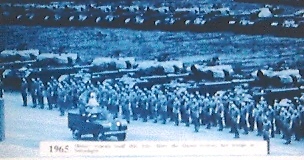
Taff Lewis, Merv Davies and Brummie Crawford on break during rehearsals for the Queen's visit to Sennelager May 1965

- RE Museum
- Royal Engineers Association
- Sapper Shop
- Sappers.co.uk
- Corps of Royal Engineers Official Site
- 11 Independent Field Squadron RE
- Corps Memorial Book
- BAOR Locations
- Think Defence
- Britishbattles.com
- The Long, Long Trail
- LIGHTBOBS
- WW2history.com
- WinterlineVenafro
- 4th Division Order of Battle 1939-1945
- Linea Gustav
- The Battles for Monte Cassino
- Cassinobattlefields
- Ocean Villas Tea Rooms and Guest House on the Somme
- Forces Records - History of the Royal Engineers
- 19 of the World’s Best World War II Museums and Historical Sites
- The Liberation Trilogy
- Wouldham Village History
- Italy Star Association
HM the Queen reviews her troops at Sennelager
May 1965
May 1965
7 and 9 Field Companies built this pontoon bridge over the River Marne at La Ferte sous Jouarre 9-10 September 1914, in support of the Allied counter - attack, which saw the end of the long BEF retreat from Mons.
7 Field Company are seen here manning the bridge 10 September 1914
7 Field Company are seen here manning the bridge 10 September 1914

General J.B. Glubb wrote a book based on his WW1 diary, ''Into Battle'', he concluded with this message:
1977: Many of the officers, NCO’s and men of the 7th Company wrote to me after I returned to England and some continued to do so for many years. Corporal Rennie, who was much older than I was, died many years ago. Sergeant Adams, who was with me in Sanctuary Wood in 1915, kept in touch until he died three years ago. The last of them was driver Clemmit, who became post-master at Appleton-le-Moors in Yorkshire. He kept bees on the moors and every year at Christmas he used to send me a present of honey in the comb, and continued to do so until he died in 1975, nearly sixty years since we had been together in France. Such were the comradeships of the Great War.
1977: Many of the officers, NCO’s and men of the 7th Company wrote to me after I returned to England and some continued to do so for many years. Corporal Rennie, who was much older than I was, died many years ago. Sergeant Adams, who was with me in Sanctuary Wood in 1915, kept in touch until he died three years ago. The last of them was driver Clemmit, who became post-master at Appleton-le-Moors in Yorkshire. He kept bees on the moors and every year at Christmas he used to send me a present of honey in the comb, and continued to do so until he died in 1975, nearly sixty years since we had been together in France. Such were the comradeships of the Great War.


HM Queen Elizabeth and HRH Prince Philip view British troops, Sennelager 26 May 1965. 2 Division Royal Engineers took part on the static parade
Field Engineering Training Ground. Cove 1960s

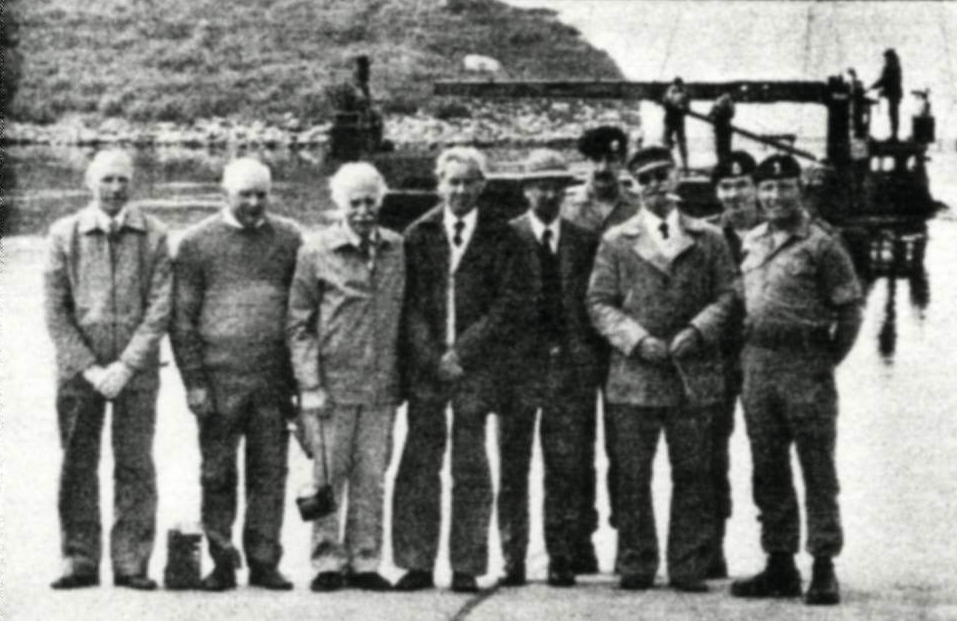
7 Field Squadron RE, Cassino Weekend 11-15 May 1984, the 40th anniversary of the Rapido Bridge Build.
Above from L-R, Arthur Bevin, Joe Gilleard, Harold Harnett, Fred Aspinal, Tommy Riordan and Vic Lovell
Above from L-R, Arthur Bevin, Joe Gilleard, Harold Harnett, Fred Aspinal, Tommy Riordan and Vic Lovell

7 Field Squadron RE, Cassino Weekend 11-15 May 1984, the 40th anniversary of the Rapido Bridge Build. 1 Troop with ''The Seven'' Amazon Bridge Veterans on the MGB
7 Field Company Video Library
WW1 and WW2
WW2 LIBRARY
Videos of the North Road.
In April 1944, 7 Field Company worked on the Allies re-supply route known as the North Road. Here are four videos of the North Road in 4 stages showing how it is today.
The North Road Stage 1
https://www.youtube.com/watch?v=ZeLuvDafWJA
The North Road Stage 2
https://youtu.be/iT-9Km8JK-A
The North Road Stage 3
https://youtu.be/CuVgjJkHrnw
The North Road Stage 4
https://youtu.be/mkUsrI-57io
Hove Dump
https://youtu.be/h9vgKbOkK8k
The Amazon Bridge site and river gap
https://youtu.be/ssLS7eBKHr0
The Amazon Bridge Gap
https://youtu.be/UwZPO4MpXfs
Joe Gilleard interviewed on Amazon Bridge Site 2004
https://youtu.be/aE0g3EFsNB4
Sgt J. Stamper and Spr J. Gilleard by RSME at Chatham 1987
https://youtu.be/hpjLj5HLgsM
The Amazon Bridge 70th Anniversary and Construction Story
https://youtu.be/8vt4ClrecO0
7 Field Company ferrying men and stores across the River Ronco 2nd November 1944
https://youtu.be/XniyCd4NQRo
The Br 4th Division Sappers in Mignano preparing for ''Operation Honker'' 1944.
https://youtu.be/yDZZgstidBg
The 4th Division sappers behind Monte Trocchio April-May 1944
https://youtu.be/cGN42DRGvhc
7 Field Company's final preparation of the approaches to Congo and Blackwater bridge sites April-May 1944
https://youtu.be/gtT2HVhCRY0
Operation 'Honker' Part 1 of 2. The 4th Division break through the Gustav Line 11th/12th May 1944
https://youtu.be/UU5SfhSDrGs
Operation 'Honker' Part 2 of 2. The construction of Amazon bridge
https://www.youtube.com/watch?v=rcyKi4Pl25k
Monte Trocchio
https://youtu.be/8htBob7uNpg
45th Anniversary of the Battle of Cassino Part 1 of 4 - Amazon Bridge Site
https://www.youtube.com/watch?v=adH3Lyxwg6E
45th Anniversary commemorations of the Battle of Cassino Part 2 of 4 The Cemeteries
https://youtu.be/SrrZOylHVt0
45th Anniversary commemorations of the Battle of Cassino Part 3 of 4 The Veterans March through Cassino
https://www.youtube.com/watch?v=Py2D2_oa__E&t=707s
Battle of Britain Bunker and Exhibition Centre Uxbridge
https://youtu.be/TXoa1DJWKgg
The 50th Anniversary of the Final Battle of Monte Cassino, May 1994
https://youtu.be/zW4KQlTnAMo
The Construction of the Amazon Bridge Memorial 11-27 October 2021
https://youtu.be/PILZkONFcHo
10 and 12 Infantry Brigades at the Rapido River Assault Crossings on the Gustav Line May 44
https://www.youtube.com/watch?v=LJuKbHgbOH0
The 28 Infantry Brigade on the River Assault Crossings on the Gustav Line May 1944
https://www.youtube.com/watch?v=JBmB54nPrho
WW1 Library
Centre de Poitiers - 7 Field Company's location on the front line trenches May 1918
https://youtu.be/TG2AajlAp9g
Centre de Poitiers (updated 25 August 2017)
https://youtu.be/seXDgFmhGeY
The Marne Pontoon Bridge Centenary Commemoration September 2014
https://youtu.be/pFtbcKyp6eM
7 Field Company's location at Becourt, France, August 1916 - 9 February 1917
https://www.youtube.com/watch?v=xBdzoqQW12U
7 Field Company's History 1917. Part One January - 14 June.
https://youtu.be/XlfTVs5rd5Q
7 Field Company's History 1917. Part two 14 June - 31 December
https://www.youtube.com/watch?v=jPtVl_hR6h0
Fere-en-Tardenois Railway Station
https://www.youtube.com/watch?v=UPgfytLBHzc
A photo collection of the Black Horse Trail 1918-2018
https://www.youtube.com/watch?v=bEVjcS8HpLs
The BHT 2018 visit 7 Field Company's 1918 'Operation Michael' sites
https://www.youtube.com/watch?v=ZxTDmvpONog
Westminster Abbey Memorial Garden 10 November 2018
https://www.youtube.com/watch?v=35KPjuTh6Zo
BHT 2018 Part 2 of 4 Operation Georgette April 1918
https://youtu.be/Ba5WGLW7q3I
BHT 2018 Part 3 of 4 Operation Gneisenau May 1918
https://youtu.be/QLGJOlIu6_g
BHT 2018 Part 4 of 4 - The Final Battles
https://youtu.be/iP5MmtaVvXw
Comments and feedback most welcome. email: georgecowie103@yahoo.co.uk
I'm proud that we have had a Black Horse Trail, (BHT) commemorating 7 Field Company in every centenary year of world war one, 1914-2014 to 1918-2018. The BHT has mirrored the path of 7 Field Company RE during their WW1 years covering all the main sites. Visiting the sites brings the past back to life and gives you a greater understanding of what they did and what they had to endure. It was a most memorable experience and an honour to commemorate those who went before us and suffered hardship and sacrifice for King and Country.
I would like to thank all those who took part.
A small compilation of Black Horse Trail photos:
BHT 2014








BHT 2015


BHT 2016


BHT 2016










Estaires Strong Posts
Caix


Venizel bridge
River Aisne at Venizel
7 & 9 Field Companies
constructed a pontoon
bridge 13 September 1914
7 & 9 Field Companies
constructed a pontoon
bridge 13 September 1914
100 Anniversary commemoration of the Pontoon bridge over the River Marne at La Ferte Sous Jouarre 9/10 September 1914- 10 September 2014
St Marguerite village
Some of the first WW1 trenches were dug here by 7 Field Company, September 1914

29th June 2019 a poppy cross was laid at the Cenotaph commemorating the men of
7 Field Company RE, who gave their lives for King and Country.
WE WILL REMEMBER THEM.
7 Field Company RE, who gave their lives for King and Country.
WE WILL REMEMBER THEM.
Books by Sir John Bagot Glubb: https://www.goodreads.com/author/list/403453.John_Bagot_Glubb_
A Tribute to Lieutenant-General Sir John Bagot Glubb, KCB, CMG, DSO, OBE, MC.
John Bagot Glubb was born in 1897, his father being a regular officer in the Royal Engineers.
At the age of four, he left England for Mauritius, where his father was posted for a three-year tour of duty. At the age of ten, he was sent to school for a year in Switzerland. These youthful travels may have opened his mind to the outside world at an early age.
He entered the Royal Military Academy at Woolwich in September 1914 and was commissioned in the Royal Engineers in April 1915. He served throughout the First World War in France and Belgium with 7 Field Company RE, being wounded three times and awarded the Military Cross.
In 1920 he volunteered for service in Iraq, as a regular officer, but in 1926 resigned his commission and accepted an administrative post under the Iraq Government.
In 1930, however, he signed a contract to serve the Transjordan Government (now Jordan).
From 1939 to 1956 he commanded the famous Jordan Arab Legion, which was, in reality, the Jordanian Army. Since his retirement, he has published seventeen books, chiefly on the Middle East, and has lectured widely in Britain, the United States and Europe.
7 Field Company RE
Lieutenant General J.B. Glubb KCB. CMG. DSO. OBE. MC, started his army career with 7 Field Company RE, joining the Company 28 November 1915 as a Second Lieutenant in command of No 1 Section (troop or platoon strength).
While serving with the Company he was wounded three times and was twice evacuated to England, once through illness and once through a serious injury to the jaw. The fast turnover of men in wartime saw him quickly become senior section commander and often had to fill in as second in command and O.C of the Company. He enjoyed his time in the Company and when he was declared fit to return to France after his injury, he got his father, the C.E. II Corps, to arrange that he returns to 7 Field Company where he remained with the Company until February 1919. While he served in the Company he kept a diary, which is used alongside 7 Field Company's war diary on this website providing a wealth of information on the events during those times. General Glubb died 17 March 1986 aged 88.
For more information click on the link.
John Bagot Glubb was born in 1897, his father being a regular officer in the Royal Engineers.
At the age of four, he left England for Mauritius, where his father was posted for a three-year tour of duty. At the age of ten, he was sent to school for a year in Switzerland. These youthful travels may have opened his mind to the outside world at an early age.
He entered the Royal Military Academy at Woolwich in September 1914 and was commissioned in the Royal Engineers in April 1915. He served throughout the First World War in France and Belgium with 7 Field Company RE, being wounded three times and awarded the Military Cross.
In 1920 he volunteered for service in Iraq, as a regular officer, but in 1926 resigned his commission and accepted an administrative post under the Iraq Government.
In 1930, however, he signed a contract to serve the Transjordan Government (now Jordan).
From 1939 to 1956 he commanded the famous Jordan Arab Legion, which was, in reality, the Jordanian Army. Since his retirement, he has published seventeen books, chiefly on the Middle East, and has lectured widely in Britain, the United States and Europe.
7 Field Company RE
Lieutenant General J.B. Glubb KCB. CMG. DSO. OBE. MC, started his army career with 7 Field Company RE, joining the Company 28 November 1915 as a Second Lieutenant in command of No 1 Section (troop or platoon strength).
While serving with the Company he was wounded three times and was twice evacuated to England, once through illness and once through a serious injury to the jaw. The fast turnover of men in wartime saw him quickly become senior section commander and often had to fill in as second in command and O.C of the Company. He enjoyed his time in the Company and when he was declared fit to return to France after his injury, he got his father, the C.E. II Corps, to arrange that he returns to 7 Field Company where he remained with the Company until February 1919. While he served in the Company he kept a diary, which is used alongside 7 Field Company's war diary on this website providing a wealth of information on the events during those times. General Glubb died 17 March 1986 aged 88.
For more information click on the link.
Short clip, Sir John B. Glubb Knighted: https://youtu.be/1wsJbMiMSH8
The Victoria Cross

The grave of Sergeant-Major Lendrim, V.C. at Sandhurst
Corporal Lendrim was the first non-Officer Royal Engineer soldier (at that time he would have been a corporal in the 7th Company Royal Sappers and Miners) to be awarded the V.C.

Sketch of the Amazon bridge launch from the report made of the build after the event.
Boots DMS


Amazon Bridge Memorial
The Amazon Bridge Memorial construction was completed on 26 October 2021 by a handful of former 7 Fd Sqn veterans and Mr Ron Gilleard whose father served with 7 Fd Coy when they took part in building the Amazon Bridge. The memorial was funded by the Royal Engineers Association Headquarters. We are indebted to Cassino Adventure who were most helpful in the construction and without whom, we would have struggled to complete the project. The official opening ceremony will be on 13 May 2022.
The Amazon Bridge Memorial construction was completed on 26 October 2021 by a handful of former 7 Fd Sqn veterans and Mr Ron Gilleard whose father served with 7 Fd Coy when they took part in building the Amazon Bridge. The memorial was funded by the Royal Engineers Association Headquarters. We are indebted to Cassino Adventure who were most helpful in the construction and without whom, we would have struggled to complete the project. The official opening ceremony will be on 13 May 2022.
The Battle of the Ypres-Comines Canal 27 May 1940. Check it out here.
http://www.shiny7.uk/Shiny71940.html
http://www.shiny7.uk/Shiny71940.html
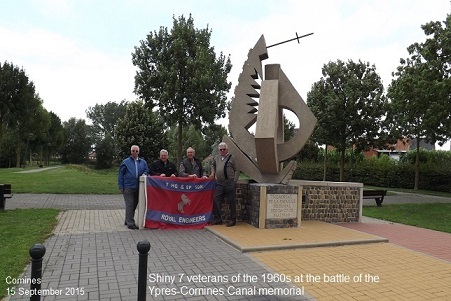



2 Division TRF


My Memories of 7 Field Squadron Royal Engineers
&
it's History
&
it's History
There are many pages of photographs and all the Squadron's history covering from the early 1800s. Choose from the menu on the left.
I hope you find it of interest.
I hope you find it of interest.
George Cowie BEM
Served in the Shiny 7th
March 1965 - November 1969
Served in the Shiny 7th
March 1965 - November 1969












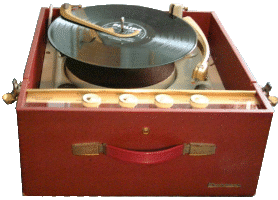
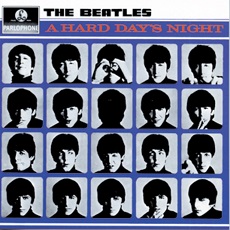
Our room entertainment in the 1960s

Osnabruck in the 1960s we rented radios from 'Titch' the camp barber. He came around the squadron blocks on a Friday to collect his money and if he found you, sometimes he would get paid.
The Amazon bridge 70th Anniversary
Contact me: if you have a story to tell or you require further information.
georgecowie103@yahoo.co.uk
7 Field Company RE, cleared many mines in Tunisia, Italy and Greece in WW2

The Amazon Bridge Construction team. October 2021
Ian Singleton, George Cowie, Chris Ellis, Ronald Gilleard
Ian Singleton, George Cowie, Chris Ellis, Ronald Gilleard

The Amazon Bridge construction team also constructed a memorial for the 1/6 Bn East Surrey Regt on Point 36, which they captured. The area where the Amazon Bridge Memorial is located and the point where the first tanks to cross the bridge headed for

Amazon Bridge Memorial 13 May 2022

Above: Major Jeffrey Daniels leads a contingent of the Home Guard in WW2.
Major Daniels served as a Pioneer in 7 Field Company RE, 1914 to February 1915. He kept a diary during this time and is included in segments on the 7 Coy 1914 page.
Photo: courtesy Carol Watt.
Major Daniels served as a Pioneer in 7 Field Company RE, 1914 to February 1915. He kept a diary during this time and is included in segments on the 7 Coy 1914 page.
Photo: courtesy Carol Watt.

Above: Pioneer Daniels third from the right standing. Most likely at Wouldham training camp.
Photo: courtesy Carol Watt
Photo: courtesy Carol Watt
Right: Colonel H.G. Pottle OBE.MC.MiD. Served in 7 Field Company 1917-18. He was shot and wounded in the arm on the 27 May 1918 and evacuated.
He went on to serve in WW2 and helped plan the invasion of Sicily and mainland Italy. As Deputy Director of Transportation, he was responsible for all the ports and railways being used by the British Army in that theatre.
Photo: courtesy Sue Pottle.
He went on to serve in WW2 and helped plan the invasion of Sicily and mainland Italy. As Deputy Director of Transportation, he was responsible for all the ports and railways being used by the British Army in that theatre.
Photo: courtesy Sue Pottle.


Above: Me exiting the River Weser,
Wouldam Hard, 1966.
Chris Ellis seen above the floatation screen is commanding and instructing on FV432 river crossings
Wouldam Hard, 1966.
Chris Ellis seen above the floatation screen is commanding and instructing on FV432 river crossings
On receipt of the FV432 the Squadron went to Petershagen on 'Floatation' training on the River Weser,1966
Quotes on Sappers
"The Sappers really need no tribute from me; their reward lies in the glory of their achievement. The more science intervenes in warfare, the more will be the need for engineers in field armies; in the late war there were never enough Sappers at any time. Their special tasks involved the upkeep and repair of communications; roads, bridges, railways, canals, mine sweeping. The Sappers rose to great heights in World War II and their contribution to victory was beyond all calculations."
- Field Marshal Bernard Law Montgomery, 1st Viscount Montgomery of Alamein, 1945
"In the event that the situation had deteriorated and a break-in operation to Sarajevo....had become necessary then armoured engineers would have been the lead element. Once again we are reminded that there comes a time in war when Sappers have to go in front to open up the way.
'Follow the Sapper' is a timeless cry."
- Brigadier I.T.D. McGill's Report to the Corps, 1995
Having seen your chaps at work, I can unequivocally state theirs was consistently the most dangerous job undertaken during the war.
I well remember waiting, on a pitch black night, while a Bailey Bridge was speedily constructed to allow our tanks to move forward. The enemy, knowing something was going on, laid down sporadic mortar fire against which, unlike the tank crews the sappers had absolutely no protection.
Often seen are polls on what/who played the most important role during the war - too often lumping ground operations with those in the air and at sea. As to the first mentioned, the Royal Engineers certainly has my vote - remember the other vital tasks they performed!
Gerry ww2 Veteran (from ww2 forum)
"The Sappers really need no tribute from me; their reward lies in the glory of their achievement. The more science intervenes in warfare, the more will be the need for engineers in field armies; in the late war there were never enough Sappers at any time. Their special tasks involved the upkeep and repair of communications; roads, bridges, railways, canals, mine sweeping. The Sappers rose to great heights in World War II and their contribution to victory was beyond all calculations."
- Field Marshal Bernard Law Montgomery, 1st Viscount Montgomery of Alamein, 1945
"In the event that the situation had deteriorated and a break-in operation to Sarajevo....had become necessary then armoured engineers would have been the lead element. Once again we are reminded that there comes a time in war when Sappers have to go in front to open up the way.
'Follow the Sapper' is a timeless cry."
- Brigadier I.T.D. McGill's Report to the Corps, 1995
Having seen your chaps at work, I can unequivocally state theirs was consistently the most dangerous job undertaken during the war.
I well remember waiting, on a pitch black night, while a Bailey Bridge was speedily constructed to allow our tanks to move forward. The enemy, knowing something was going on, laid down sporadic mortar fire against which, unlike the tank crews the sappers had absolutely no protection.
Often seen are polls on what/who played the most important role during the war - too often lumping ground operations with those in the air and at sea. As to the first mentioned, the Royal Engineers certainly has my vote - remember the other vital tasks they performed!
Gerry ww2 Veteran (from ww2 forum)

Quotes on Sappers
"The Sappers really need no tribute from me; their reward lies in the glory of their achievement. The more science intervenes in warfare, the more will be the need for engineers in field armies; in the late war there were never enough Sappers at any time. Their special tasks involved the upkeep and repair of communications; roads, bridges, railways, canals, mine sweeping. The Sappers rose to great heights in World War II and their contribution to victory was beyond all calculations."
- Field Marshal Bernard Law Montgomery, 1st Viscount Montgomery of Alamein, 1945
"In the event that the situation had deteriorated and a break-in operation to Sarajevo....had become necessary then armoured engineers would have been the lead element. Once again we are reminded that there comes a time in war when Sappers have to go in front to open up the way.
'Follow the Sapper' is a timeless cry."
- Brigadier I.T.D. McGill's Report to the Corps, 1995
Having seen your chaps at work, I can unequivocally state theirs was consistently the most dangerous job undertaken during the war.
I well remember waiting, on a pitch black night, while a Bailey Bridge was speedily constructed to allow our tanks to move forward. The enemy, knowing something was going on, laid down sporadic mortar fire against which, unlike the tank crews the sappers had absolutely no protection.
Often seen are polls on what/who played the most important role during the war - too often lumping ground operations with those in the air and at sea. As to the first mentioned, the Royal Engineers certainly has my vote - remember the other vital tasks they performed!
Gerry ww2 Veteran (from ww2 forum)
"The Sappers really need no tribute from me; their reward lies in the glory of their achievement. The more science intervenes in warfare, the more will be the need for engineers in field armies; in the late war there were never enough Sappers at any time. Their special tasks involved the upkeep and repair of communications; roads, bridges, railways, canals, mine sweeping. The Sappers rose to great heights in World War II and their contribution to victory was beyond all calculations."
- Field Marshal Bernard Law Montgomery, 1st Viscount Montgomery of Alamein, 1945
"In the event that the situation had deteriorated and a break-in operation to Sarajevo....had become necessary then armoured engineers would have been the lead element. Once again we are reminded that there comes a time in war when Sappers have to go in front to open up the way.
'Follow the Sapper' is a timeless cry."
- Brigadier I.T.D. McGill's Report to the Corps, 1995
Having seen your chaps at work, I can unequivocally state theirs was consistently the most dangerous job undertaken during the war.
I well remember waiting, on a pitch black night, while a Bailey Bridge was speedily constructed to allow our tanks to move forward. The enemy, knowing something was going on, laid down sporadic mortar fire against which, unlike the tank crews the sappers had absolutely no protection.
Often seen are polls on what/who played the most important role during the war - too often lumping ground operations with those in the air and at sea. As to the first mentioned, the Royal Engineers certainly has my vote - remember the other vital tasks they performed!
Gerry ww2 Veteran (from ww2 forum)
Maj General Alastair Dickinson CBE (retired) President of the Royal Engineer Association and the Mayor of Cassino, Enzo Salera,
lay wreaths on the Amazon bridge memorial, 13 May 2022
lay wreaths on the Amazon bridge memorial, 13 May 2022
Amazon bridge memorial dedicated to the 4th Division Royal Engineers of May 1944
13 May 2022

General Alastair Dickinson CBE (ret) presents the team from Cassino Adventure with a plaque in recognition of their exceptional support with providing the sites for four, 4th Division's memorials including the Amazon bridge memorial


The ceremony 13 May 2022

New; River Gari Battlefield Tour Cassino:-

































































































